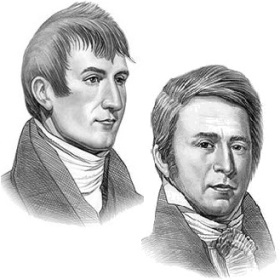|
|
|
|
|
|
14. She received the sad news that her parents had died but also the good news that her brother, Cameahwait, had become the new chief of the Shoshone tribe. Her brother agreed to sell some of the horses to the Lewis and Clark expedition and they continued their journey of exploration. 15. On November 15, 1805 the Lewis and Clark expedition at last reached the Pacific Ocean. 16. The only request she ever made on the journey was to be allowed to see the great Pacific Ocean and the whale that had been washed ashore. 17. The Lewis and Clark expedition set up their winter quarters and built Fort Clatsop where they spent 106 days from December 7, 1805 until March 23, 1806 in the Oregon Country near the mouth of the Columbia River. 18. During the journey home Pomp fell ill with a fever and, according to the journals, was treated by William Clark and soon recovered. 19. On July 25, 1806 the expedition were traveling along the Yellowstone River. William Clark climbed a 200-feet tall rock and named it “Pompy’s Tower” after Jean Baptiste. 20. On August 17, 1806 the Lewis and Clark expedition arrived back at Fort Mandan. Toussaint Charbonneau was paid $533.33 and given 320 acres of land for his service as interpreter. Sacagawea received nothing at all. 21. On September 6, 1806 the Lewis and Clark expedition reached St. Louis, Missouri. William Clark offered to raise Pomp as his own and provide him with an education. Jean Baptiste stayed with Clark who enrolled him in a boarding school. 22. Charbonneau and Sacagawea moved to Ford Manuel Lisa and on August 12, 1812 Sacagawea gave birth to a baby girl who was named Lizette. 23. Sacagawea was believed to have died on December 20, 1812 in South Dakota. The cause of death was putrid fever or typhus. 24. In 1813 William Clark signed the adoption papers for both her children 25. So ended the life of the Shoshone heroine. It should have been the end of her story. However, in 1875 a woman living in the Wind River Reservation, Wyoming, with the Comanche name of Porivo, claimed to be Sacagawea. Porivo died in 1884 but left a mystery surrounding the famous heroine. 26. There was considerable speculation about this famous woman and in 1925, Dr. Charles Eastman was hired by the Bureau of Indian Affairs to locate Sacagawea's remains and investigate her death. 27. Dr, Eastman went to the Wind River Reservation and he came to the conclusion that Porivo was Sacagawea. |
| Mobile Website Menu |
|
|
|
Published 2015 |
Modified 2018 |

